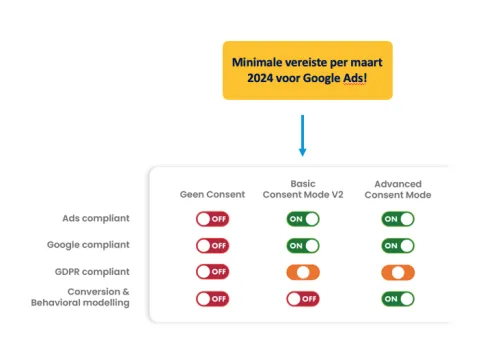We have often written and talked about it; the disappearance of Third-Party cookies. For a long time, we discussed the plans of various companies like Google, but in 2024 it will really happen. The disappearance of this type of cookies will have a major impact on how we as online marketers measure and use user behavior for our campaigns. But don't panic! We have outlined a number of steps to help you prepare for a world without third-party cookies.
Step 1: Implement Consent Mode V2
By March 2024
If your company is active as an advertiser on Google Ads, it is important to know that Google has set new requirements for advertisers. From March 2024, it is mandatory to implement Consent Mode as an advertiser. If you want a deep dive into how Consent Mode works, we recommend reading this article.
What is consent mode?
Consent Mode is the collection of additional signals from users who have not given permission to access their personal data or browser storage for data collection. These signals are then used by Google to model conversions (Google Ads, Floodlight, etc.) and visitor behavior (Google Analytics 4).

What are the benefits of Consent Mode?
- Better respect for user privacy preferences.
- GDPR-compliant data collection.
- Still send anonymized data where it would normally be lost.
- Meets the requirements for advertisers that Google enforces from March.
What happens if you don't set up consent mode?
To continue advertising through Google services, it is mandatory to implement Consent Mode V2. There are different configurations of Consent Mode possible:
- No (linked) cookie banner/No Consent Mode
It is assumed that user consent is given.
Not compliant with new requirements - Basic Consent Mode
Data is only collected if the user gives consent.
Compliant with new requirements
- Advanced Consent Mode
Data is collected from users when they give consent and when they refuse consent.
Compliant with new requirements
As indicated, it will be mandatory from March 2024 to at least implement “Basic Consent Mode V2”. This ensures that you can continue advertising through Google's services.

How to ensure Consent Mode V2 is implemented and you meet Google's requirements.
At Follo, we implement Consent Mode V2 via Google Tag Manager in combination with a CMP like Cookiebot. This is a future-proof and efficient way to comply with the new rules. Additionally, there is the option to set up Consent Mode via the gtag.js consent commands. However, this method is much more complex and requires a developer.
At Follo, we are an official partner of Cookiebot and can therefore help you excellently with setting up Consent Mode via Cookiebot. If you have any questions about this, please contact us.

Step 2: Enhanced Conversions
Advice: by June 2024
Earlier, we wrote extensively about the arrival of Enhanced Conversions in this article. With all the changes in the world of cookies, it is even more important to collect as complete data as possible. This ensures that you can continue to use your advertising campaigns as effectively as possible in the future, without losing sight of privacy.
Enhanced conversions in brief
Enhanced conversions is a feature you can use to improve the accuracy of conversion measurements and bid more effectively on Google Ads campaigns. This feature complements your existing conversion tags by allowing hashed conversion data from your website to be sent to Google while maintaining privacy.
The benefits of Enhanced Conversions
- Measure conversions that would otherwise not be measured.
- Improved bid optimization through more available data.
- Privacy-safe by hashing first-party data.
What is the effect if enhanced conversions are not implemented?
- You miss conversion data.
- Less optimal bid optimization of the advertising budget.
- Inaccurate conversion measurements.
How do enhanced conversions work?
When a website visitor completes a conversion action on the website, the website collects customer data such as: an email address, name, home address, or phone number. This data can be captured using a tag for retaining conversions. In enhanced conversions, this customer data is encrypted and sent to Google. The encrypted data is compared with logged-in Google accounts to attribute conversions to ad events.
Setting up Enhanced Conversions
To use Enhanced Conversions, it is necessary that certain data such as phone number, email address, or name and place of residence are available at the conversion. In many cases, this means that these variables need to be added to the data layer and changes made to the website's tagging. Our data specialists can help you extensively to ensure that enhanced conversions are also set up for you.
Step 3: Server Side Tracking
By September 2024
You may have heard the term Server-Side Tracking recently. Our data specialist Yasin has already spoken extensively about Server Side Tracking in this video.
Prefer reading? Then check out this article.
By the end of 2024, Google Chrome will stop using third-party cookies, following Safari and Firefox. But why is the phasing out of third-party cookies from Chrome such a big deal? That's because Chrome has by far the most users. In the Netherlands, about 54 percent of all users use Chrome as a browser. On desktop, this percentage is slightly higher than for mobile use. Changes from Chrome therefore affect more than half of your users.
Server Side Tracking in brief
Server-side tracking is a method where data is collected on your own server before being forwarded to other platforms. Think of platforms like Google Analytics, Facebook, Instagram, or LinkedIn. Unlike client-side tracking, the data is no longer collected in the end user's browser.
Client-Side vs Server-Side Tagging
The benefits of Server Side Tracking
- Accurate tracking
The events and sessions can be traced back to the same user for longer, allowing them to be better linked to your marketing channels. - Third-party to first-party cookies
Unlike client-side tracking, data in server-side tracking is first sent from the user's browser to the website's own server, so this is first-party data.
- Bypass Ad-Blockers
The data is now collected through our own domain instead of the well-known Google domain, which is not recognized by Ad-Blockers.
- Improved website performance
Only one tracking script is loaded in the user's browser, reducing the website's load time.
Getting started with Server Side Tracking
Unlike Client-Side Tracking, Server-Side Tracking involves monthly costs for servers and their usage. Our data specialists are happy to help you set up Server Side Tracking via reliable Google servers within the EU. If you want to know more about this, we are happy to advise you!
Recap
2024 is a year in which we will all face major shifts from third-party to first-party data. This will have a serious impact on virtually every organization that is active online if not all necessary steps are taken. In summary, there are a number of changes that need to be made in the coming period.
- Implement Consent Mode
- Add Enhanced Conversions
- Implement Server Side Tracking
You may already have some things in place. For this reason, one of our data specialists will be happy to look at your situation to determine if you are ready for the upcoming changes. If you have questions or need help, please contact us.




